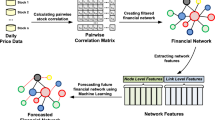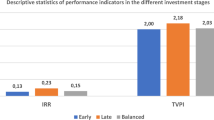Abstract
This paper analyses the Dow Jones daily industry sector total return indices for the last 18 years and the Data Stream daily industry sector price indices over the past 30 years. We show how broad movements in both sets of data can be described in terms of five underlying variables and how interactions between individual industrial sectors can be revealed using structural equation modeling. In addition we show how these factors can be used to construct investible factor portfolios that can be used to take a position in the securities market and how normal investment tools such as the capital asset pricing models should be used to construct an optimal investment portfolio. Whilst the methodologies used are somewhat mathematical our aim is not to explain the math, but to show a way in which the tools are applied and the results interpreted.







Similar content being viewed by others
References
Black F, Jensen MC, Scholes M (1972) The capital asset pricing model: some empirical tests. In: Jensen M (ed) Studies in the theory of capital markets. Praeger, New York
Blin LM, Bender S, Guerard JB (1997) Earnings forecasts, revisions and momentum in the estimation of efficient market-neutral Japanese and U.S. portfolios. In: Chen A (ed) Research in finance, 15th edn. JAI Press, Greenwich, CT, pp 93–114
Bodie Z, Kane A, Marcus AJ (2010) Investments. Irwin/McGraw-Hill, New York
Brown SJ (1989) The number of factors in security returns. J Financ 44(5):1247–1262
Chandra M (2005) Estimating and explaining extreme comovements in Asia–Pacific equity markets. Rev Pac Basin Financ Mark Policy 8(1):53–79
Chen N, Roll R, Ross S (1986) Economic forces and the stock market. J Bus 59(3):383–403
Cohen K, Pogue G (1967) An empirical evaluation of alternative portfolio models. J Bus 40(2):166–193
Connor G, Korajczyk R (1993) A test for the number of factors in an approximate factor model. J Financ 48(4):1263–1291
Dhrymes PJ, Friend I, Gultekin NB (1984) A critical reexamination of the empirical evidence on the APT. J Financ 39(2):323–346
Dhrymes PJ, Friend I, Gultekin MN, Gultekin NB (1985) New tests of the APT and their implications. J Financ 40(3):659–674
Elton EJ, Gruber MJ, Padberg MW (1978) Simple criteria for optimal portfolio selection: tracing out the efficient frontier. J Financ 33(1):296–302
Farrell JL (1974) Analyzing covariation of returns to determine homogeneous stock grouping. J Bus 47(2):186–207
Farrell JL (1997) Portfolio management: theory and applications. Irwin/McGraw-Hill, New York
Feeney GJ, Hester DD (1967) Stock market indices: a principal components analysis. In: Hester DD, Tobn J (eds) Risk aversion and portfolio choice. Wiley, New York
Fletcher J (2001) An examination of alternative factor models in UK stock returns. Rev Quant Financ Acc 16(2):117–130
Fogler H (1982) Common sense on CAPM, APT and correlated residuals. J Portf Manag 8(4):20–28
Fogler HK, John K, Tipton J (1981) Three factors, interest rate differentials and stock groups. J Financ 36(2):323–336
Fox J (2006) Structural equation modeling with the SEM package in R. Struct Equ Model 13(3):465–486
Hooper D, Coughlan J, Mullen MR (2008) Structural equation modelling: guidelines for determining model fit electronic. J Bus Res Method 6(1):53–60
Hu LT, Bentler PM (1999) Cutoff criteria for fit indexes in covariance structure analysis: conventional criteria versus new alternatives. Struct Equ Model 6(1):1–55
Jöreskog KG (1977) Structural equation models in the social sciences: specification estimation and testing. In: Krishnaiah PR (ed) Applications of statistics. North-Holland, Amsterdam
Jöreskog KG, Goldberger AS (1975) Estimation of a model with multiple indicators and multiple causes of a single latent variable. J Am Stat Assoc 70(351):631–639
Jöreskog KG, Sorbom D (1981) LISREL V, analysis of linear structural relationships by the method of maximum likelihood. National Educational Resources, Chicago
Jöreskog KG, Sorbom D (1989) LISREL 7: a guide to the program and applications. SPSS, Chicago
Jöreskog KG, Yang F (1996) Non-linear structural equation models: the Kenny-Judd model with interaction effects. In: Marcoulides GA, Schumacker RE (eds) Advanced structural equation modeling: issues and techniques. Lawrence Erlbaum Associates, Hillsdale, NJ, pp 57–88
King BJ (1966) Market and industry factors in stock price behavior. J Bus 39(1):139–190
Lattin ML, Carroll JD, Green EG (2003) Analyzing multivariate data. Brooks/Cole Cennage Learning, Pacific Grove, CA
Lee CF, Wei JKC (1984) Multi-factor, multi-indicator approach to asset pricing model: theory and empirical evidence. Working paper
Lee CF, Wei JKC, Chen HY (2012) Multi-factor, multi-indicator approach to asset pricing model: theory and empirical evidence. In: Lee CF, Lee AC, Lee JC (eds) Handbook of financial econometrics and statistics. Springer, Berlin
Meric I, Ratner M, Meric G (2005) Co-movements of the world’s sector index returns. Int J Financ 17(1):3376–3391
Meric I, Ratner M, Lentz C, Meric I (2006) Global portfolio diversification implications of the co-movements of Latin American stock markets with the world’s other stock markets. J Emerg Mark 11(3):32–39
Meric I, Ratner M, Meric G (2008) Co-movements of sector index returns in the world’s major stock markets in bull and bear markets: portfolio diversification implications. Int Rev Financ Anal 17(1):156–177
Mohanty SK, Akhigbe A, Al-Khyal TA, Bugshan T (2013) Oil and stock market activity when prices go up and down: the case of the oil and gas industry. Rev Quant Financ Acc 41(2):253–272
Nandha M, Brooks R (2009) Oil prices and transport sector returns: an international analysis. Rev Quant Financ Acc 33(4):393–409
Roll R (1977) A critique of the asset pricing theory’s tests part I: on past and potential testability of the theory. J Financ Econ 4(2):129–176
Roll R (1984) The arbitrage pricing theory approach to strategic portfolio planning. Financ Anal J 40(3):14–26
Roll R, Ross R (1980) An empirical investigation of the arbitrage pricing theory. J Financ 35(5):1073–1103
Rosenberg B (1974) Extra-market components of covariance in security returns. J Financ Quant Anal 9(2):263–274
Rosenberg B, McKibben W (1973) The prediction of systematic and specific risk in common stocks. J Financ Quant Anal 8(2):317–333
Ross S (1976) The arbitrage theory of capital asset pricing. J Econ Theory 13(3):341–360
Schiller R (1999) Human behavior and the efficiency of the financial system. In: Taylor JB, Woodford M (eds) Handbook of macroeconomics, vol 1. Elsevier, pp 1305–1340
Sharpe W (1963) A simplified model for portfolio analysis. Manag Sci 9(2):277–293
Sharpe W (1964) Capital asset prices: a theory of market equilibrium under conditions of risk. J Financ 19(3):425–442
Sharpe W (1984) Factor models, CAPMs and the APT. J Portf Manag 11:21–25
Steiger JH (1998) A note on multiple sample extensions of the RMSEA fit index. Struct Equ Model 5(4):411–419
Strang G (2009) Introduction to linear algebra. Cambridge Press, Wellesley
Tychonoff A (1943) On the stability of inverse problems. Dokl Akad Nauk SSSR 39(5):195–198
Yuan K, Chan W (2008) Structural equation modeling with near singular covariance matrices. Comput Stat Data Anal 52(10):4842–4858
Author information
Authors and Affiliations
Corresponding author
Rights and permissions
About this article
Cite this article
Poynter, J.G., Winder, J.P. & Tai, T. An analysis of co-movements in industrial sector indices over the last 30 years. Rev Quant Finan Acc 44, 69–88 (2015). https://doi.org/10.1007/s11156-013-0399-z
Published:
Issue Date:
DOI: https://doi.org/10.1007/s11156-013-0399-z




